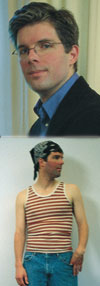
|
|
| The Last Word |
|
I spent my five years as an Oberlin student woefully overdressed. I arrived that way in the fall of 1986, the product of a preppy metropolitan suburb where appearances mattered, even on weekends. The high-school wardrobe I imported to Oberlin was devoid of standard student clothing: ripped jeans, faded t-shirts, oversized sweatshirts, worn-out sneakers. Always neatly groomed, I wore corduroy pants, button-down shirts, shoes and socks to match--formalwear by campus fashion standards. Rarely dressed otherwise, my appearance tended to set me apart, although less so in the Conservatory, where there were, well, voice majors with whom to blend in. Nevertheless, I was married to my wardrobe, it was me and I, it. I couldn't imagine changing my ways, and I didn't. And I haven't, not in the ten years since graduating, and this has become a point of personal concern. A comment from my housemate, Jan, a few months ago first raised my awareness. "You're always so nicely dressed, and you work at home!" True, I hadn't seen anyone that day and yet I was wearing slacks and an oxford shirt. I could have added a jacket and tie in a second and been out the door to the opera. My clothing style had become rigid. How had I become trapped so young? The next morning I stood before my closet determined to dress down. Well, I tried. And failed. Presenting myself to Jan that evening, she just rolled her eyes. "That's about as casual as you can get, isn't it?" Ashamed, I slunk back into my room, filled with anxiety. What was wrong with me? I blame my parents. They blame each other, which is only natural, as they're both guilty. If he were gay, my father would be what we call a "clothes queen." His wardrobe is his supreme indulgence, or at least, his most consistent one. My friends tend to reel back in horror when I tell them that my mother never allowed my older brother or me to go to school in jeans. She didn't consider them "appropriate," despite what the vast majority of other parents believed. The nicer the merchandise she could get us to wear, the better. The minute my brother landed at college, he threw off the cloak of oppression. Going casual is no problem for him; it is de rigueur. So the ideal modeled, literally and figuratively, by my father was supported and encouraged by my mother (who is no slouch, either). My brother rebelled before I could, and I didn't want to appear to be imitating him, so what was I to do? I am, I have come to realize, "casually impaired." Not only do I own few clothes most people would consider casual, I don't feel comfortable looking as though I just got up and threw something, anything, on. I've consulted my friend and Oberlin classmate Celise for help. We've been hanging out recently, both looking for the man of our dreams. She listened patiently to my self-diagnosis with a grin, as if to say, "Finally! I never thought you'd come around!" Then we went shopping. I knew the minute we walked into Banana Republic (her choice) that I might have a problem. If I am going to shop at a large chain, this is the one I turn to, and have, too many times. The clothes can be a bit pricey, but they almost always look good, more dressy than not. That's when I had another realization: as much as my friends chide me, they're used to my being this way, perhaps even a bit invested. After so many years of knowing a person one way, we often don't want them to change, however insignificantly. I've started to pursue my own self-help plan. As with any 12-step program, admitting one has a problem is the first thing to do. Mine goes deep. But I've arrived at a point in my life whereby I don't want to feel impaired like this, unable to face the world in anything less than khakis and a polo shirt. For a long while, clothes were my shield from fears stirred up by childhood nightmares of suddenly standing naked, exposed, and embarrassed in front of a large group of people, usually my peers. Yet dressy clothes also assert a certain superiority, however shallow, and this can be distancing. I don't need the security anymore. Although I'm uncertain if I'll ever be able to completely break free, or achieve that "just-put-on-whatever-was-around" look that I envy for the way it conveys spontaneity and self-ease. I fear I'll look fake. I've been studying catalogues from places like Eddie Bauer, those poster size pictures in stores like Abercrombie & Fitch, and eyeing the racks at Old Navy for ideas. As a gay man, I think I'll always be prone to overcompensating, my reaction to being different. But I'm trying, watching people on the street, observing what might work (e.g. shirt untucked and hanging out below the sweater) and what is totally out of the question (e.g. tie-dye). "Baby steps" as a friend of mine likes to say, a gradual evolution toward freeing myself, a bit, from the confines of my past. Just put the iron down, I tell myself, let the wrinkles be. Peter Nicholson is a writer and designer. He can be reached at psn68@ix.netcom.com |
 Confessions
of the Casually Impaired
Confessions
of the Casually Impaired